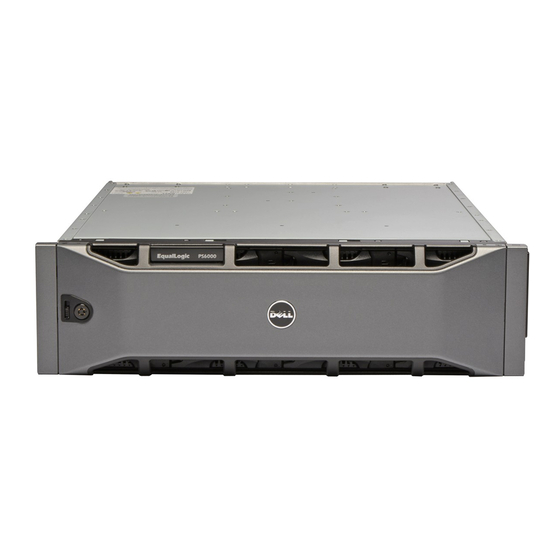Dell EqualLogic PS6100XV 하드웨어 매뉴얼 - 페이지 38
{카테고리_이름} Dell EqualLogic PS6100XV에 대한 하드웨어 매뉴얼을 온라인으로 검색하거나 PDF를 다운로드하세요. Dell EqualLogic PS6100XV 50 페이지. Equallogic ps series storage products
Dell EqualLogic PS6100XV에 대해서도 마찬가지입니다: 개요 (7 페이지)

CAUTION: If you want to mount the volume of a snapshot, clone, or replica using the Group Manager GUI, mount it
to a standalone node or a cluster node in a different cluster. Do not mount the snapshot, clone, or replica of a
clustered disk to a node in the same cluster because it has the same disk signature as the original clustered disk.
Windows detects two disks of the same disk signature and changes the disk signature on one of them. Most of the
time, Windows tries to change the disk signature of the snapshot, clone, or replica. If its access type is Read-Only,
Windows is unable to change the signature and thus the volume is not mounted. If its access type is Read-Write,
Windows is able to change the disk signature. When you try to restore the disk later, the cluster's physical
resource fails due to a different disk signature. Although it is rare, under some conditions, Windows can change
the disk signature on the original disk because it misidentifies the snapshot, clone, or replica as the cluster disk.
That situation may result in data loss or an inaccessible snapshot, clone, or replica.
NOTE: For more information on using ASM in the cluster, see the
Manager/Microsoft Edition User Guide at equallogic.com.
NOTE: You can use ASM to mount a snapshot, clone, or replica to the same node or another node in the same
cluster. VSS changes the disk signature of the snapshot, clone, or replica before mounting it.
Snapshots
A snapshot is a point-in-time copy of volume data that can protect against mistakes, viruses, or database corruption.
Snapshot creation does not disrupt access to the volume. Snapshots appear on the network as iSCSI targets and can be
set online and accessed by hosts with iSCSI initiators. You can recover volume data by restoring a volume from a
snapshot or by cloning a snapshot, which creates a new volume.
Creating Snapshots
To create a snapshot of the current time:
1.
Click Volumes → volume_name → Create snapshot.
The Create Snapshot dialog box is displayed.
2.
You can specify the following information in the Create Snapshot dialog box:
–
Optional snapshot description.
–
Whether you want the snapshot set offline (default) or online.
–
Whether you want the snapshot to be read-write (default) or read-only.
3.
Click OK to create the snapshot. The snapshot is displayed in the far left panel, under the volume name identified by
the date and time when it was created.
Restoring Snapshots
To restore a volume from a snapshot:
1.
Use Cluster Administrator or Failover Cluster Management to bring the cluster resource group containing the
volume offline.
2.
Use Group Administration to:
–
Bring the volume and the snapshot offline.
–
Select the volume, perform a restore, and select the snapshot to restore the volume from.
–
Bring the volume online.
3.
Use Microsoft iSCSI Initiator Service GUI to log back into the volume from each cluster node.
4.
Use Cluster Administrator or Failover Cluster Management to bring the cluster group online.
NOTE: Do not use the Group Manager GUI to mount the snapshot of a clustered disk to a node in the same cluster.
38
Host Integration Tools EqualLogic Auto-Snapshot
